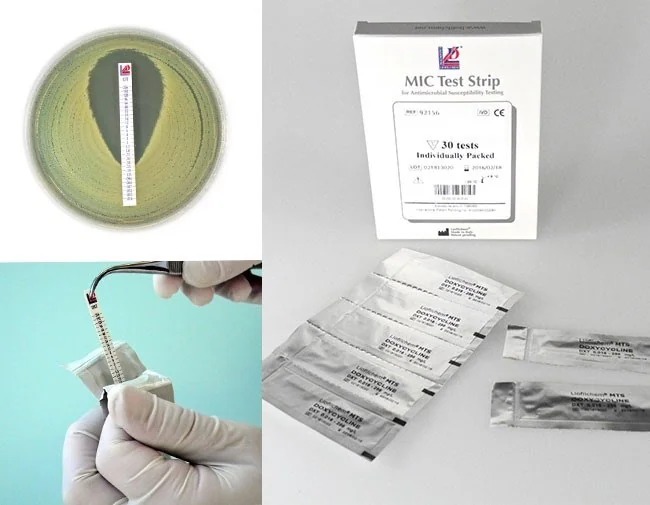Liofilchem™ MTS™ Ertapenem/Ertapenem+Cloxacillin ETP/ECX 0.125-8/0.032-2, MIC Test strips
Catalog No :
CAS Number :
Brand :
In Stock
Specifications:
| Application | Clinical microbiology |
| Storage Temperature | -20°C |
| Product Type | MIC Strips |
| Product Brand | Liofilchem |
| Product Grade | Microbiology grade |
Liofilchem™ MTS™ Ertapenem/Ertapenem+Cloxacillin (ETP/ECX) MIC Test Strips are antimicrobial susceptibility test strips designed to detect and differentiate carbapenem resistance in Enterobacteriaceae and other Gram-negative pathogens. These test strips combine Ertapenem, a carbapenem antibiotic, and Cloxacillin, an agent that targets beta-lactamase enzymes, to provide an efficient method for identifying resistance mechanisms, particularly AmpC beta-lactamases and carbapenemases.
The test strips provide MIC values (minimum inhibitory concentration) that help clinicians and microbiologists assess the effectiveness of Ertapenem against Gram-negative pathogens and determine the presence of beta-lactamase-mediated resistance.
Product Features
- Combination Testing: The strip combines two agents:
- Ertapenem (carbapenem) to test the general resistance to beta-lactam antibiotics.
- Cloxacillin to inhibit the activity of beta-lactamases, especially AmpC and carbapenemases.
- Wide MIC Range: The strips are designed to test against a range of concentrations:
- Ertapenem (0.125-8 µg/mL)
- Cloxacillin (0.032-2 µg/mL)
- Accurate Resistance Profiling: The MIC values allow for precise identification of resistant strains, helping to determine if carbapenem resistance is due to AmpC or carbapenemase production.
- Sensitivity and Selectivity: These strips have high sensitivity for detecting carbapenem-resistant strains and provide specific information about beta-lactamase activity.
Test Procedure
- Preparation:
- Prepare an inoculum from a freshly cultured bacterial isolate. The inoculum should be equivalent to a 0.5 McFarland standard.
- Swab the inoculum evenly over an agar plate (e.g., Mueller-Hinton Agar) using a sterile swab. Ensure uniform distribution for accurate results.
- Application of the Strips:
- Place the ETP/ECX MIC test strips on the inoculated agar plate.
- The strips should be placed approximately 10-15 mm apart to avoid interference.
- Ensure the strips are placed with their flat side down on the plate to avoid contamination.
- Incubation:
- Incubate the plate aerobically at 35–37°C for 16-20 hours.
- It is recommended to incubate for 18 hours for optimal results, though it may vary depending on the pathogen.
- Reading the Results:
- After incubation, measure the diameter of the inhibition zone around the MIC test strip.
- The zone of inhibition indicates bacterial susceptibility, while the MIC is determined based on the concentration of the antibiotic where bacterial growth is inhibited.
- Compare the zone size to the standard CLSI or EUCAST guidelines to determine resistance or susceptibility.
- Resistance Detection:
- An increase in the zone of inhibition when Cloxacillin is used indicates the presence of beta-lactamase activity, which could be due to AmpC beta-lactamases or carbapenemases.
- If no zone enlargement occurs with the combination of Ertapenem and Cloxacillin, this suggests that carbapenem resistance is not due to beta-lactamase inhibition but might be due to other mechanisms like efflux pumps or porin channel mutations.
Reference Data
| Organism | Ertapenem MIC Breakpoint | Interpretation |
|---|---|---|
| Escherichia coli | ≥ 22 mm | Resistant |
| Klebsiella pneumoniae | ≥ 22 mm | Resistant |
| Enterobacter spp. | ≥ 22 mm | Resistant |
| Pseudomonas aeruginosa | ≥ 16 mm | Susceptible |
These reference breakpoints are based on EUCAST or CLSI guidelines and are provided as general guidelines. Please refer to local guidelines for region-specific interpretation.
Control Strains:
| Control Strain | Expected Result |
|---|---|
| Escherichia coli ATCC® 25922 | Susceptible |
| Klebsiella pneumoniae ATCC® 700603 | Resistant |
| Enterobacter cloacae ATCC® 13047 | Resistant |
| Pseudomonas aeruginosa ATCC® 27853 | Susceptible |
Storage Conditions
- Long-term Storage: Store the MIC strips at -20°C to maintain the stability and efficacy of the test.
- Short-term Storage: Store the strips at 2-8°C for short-term use.
- Expiry: The strips should be used before the expiry date printed on the label.
- Keep the strips in their original packaging to prevent exposure to moisture, heat, and light.
Shelf Life:
- Shelf life is typically 24 months when stored correctly in the original packaging at recommended temperatures.
Key Advantages
- Rapid and Efficient: Provides results within 18-20 hours, allowing quick decisions regarding treatment options.
- Dual-Agent Testing: The combination of Ertapenem and Cloxacillin makes this method particularly useful for detecting carbapenem-resistant strains, including those resistant due to AmpC beta-lactamases and carbapenemases.
- Cost-Effective: More affordable and simpler than molecular testing, making it ideal for routine testing in clinical microbiology laboratories.
- Versatile: Can be used with a variety of Gram-negative bacterial pathogens, including common nosocomial pathogens like Escherichia coli, Klebsiella pneumoniae, and Enterobacter spp..
Conclusion
Liofilchem™ MTS™ Ertapenem/Ertapenem+Cloxacillin (ETP/ECX) 0.125-8/0.032-2, MIC Test Strips offer a reliable and cost-effective solution for detecting carbapenem resistance in clinical isolates. These test strips combine Ertapenem and Cloxacillin to evaluate resistance mechanisms, particularly beta-lactamase activity. By using these test strips, microbiology labs can quickly identify AmpC-producing and carbapenem-resistant organisms, enabling better antimicrobial stewardship and more informed treatment choices.
4o mini
- Pack Size: 100/pk 10/pk 30/pk




 0
0
